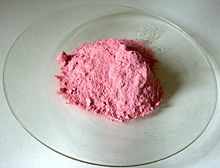Cobalt(II) acetate

| |
| Names | |
|---|---|
| IUPAC name
Cobalt(II) acetate
| |
| Identifiers | |
3D model (JSmol)
|
|
| ChemSpider | |
| ECHA InfoCard | 100.000.687 |
PubChem CID
|
|
| UNII | |
CompTox Dashboard (EPA)
|
|
| |
| |
| Properties | |
| Molar mass | 177.02124 g/mol (anhydrous) 249.08 g/mol (tetrahydrate) |
| Appearance | Pink crystals (anhydrous) intense red crystals (tetrahydrate) |
| Odor | vinegar (tetrahydrate) |
| Density | 1.705 g/cm3 (tetrahydrate) |
| Melting point | 140 °C (tetrahydrate) |
| Soluble | |
| Solubility | soluble in alcohol, dilute acids, pentyl acetate (tetrahydrate) |
Refractive index (nD)
|
1.542 (tetrahydrate) |
| Hazards | |
| NFPA 704 (fire diamond) | |
| Lethal dose or concentration (LD, LC): | |
LD50 (median dose)
|
503 mg/kg (oral, rat) |
Except where otherwise noted, data are given for materials in their standard state (at 25 °C [77 °F], 100 kPa).
| |
Cobalt(II) acetate is the cobalt(II) salt of acetic acid. It may also be found as the tetrahydrate.
It may be formed by the reaction between cobalt oxide or hydroxide and acetic acid:
- CoO + 2 HC2H3O2 → Co(C2H3O2)2 + H2O
Cobalt(II) acetate may be reacted with salenH2 to give salcomine, an oxygen-transport compound:[1]
- Co(OAc)2 + salenH2 → Co(salen) + 2 HOAc
Cobalt(II) acetate is harmful if swallowed or inhaled. It may cause an allergic skin reaction. Chronic exposure may affect heart, thyroid, lungs, and kidneys. [2]
References
- ^ Appleton, T. G. (1977). "Oxygen Uptake by a Cobalt(II) Complex". J. Chem. Ed. 54 (7): 443. doi:10.1021/ed054p443.
- ^ http://www.mallbaker.com/americas/msds/english/c4895_msds_us_default.pdf%7CMallBaker MSDS

